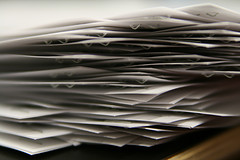 A pile of papers has slowly taken over my desk. Like a vicious mold, it started with a small bit, and it’s grown larger and larger until it seems like there’s no clear area left.
A pile of papers has slowly taken over my desk. Like a vicious mold, it started with a small bit, and it’s grown larger and larger until it seems like there’s no clear area left.
Hidden in this pile I found expired coupons, a couple of shopping lists, some recipes, a couple of articles pulled from magazines, and a very large number of web pages that I’ve printed out over the last year.
Why? I can’t seem to find the right way to organize things. I print them out and try to lie them in useful places so that I can return to them when I need them. Digging through that pile today, however, showed me that things I thought I would need in August of last year were sitting untouched at the bottom of the various collections of paper.
No system seems to click. Nothing gives me that perfect “this is RIGHT” feeling. So I’ve gone through the lists and tried to find a new way to deal with them, a way that doesn’t result in a lot of dusty piles of paper. Here’s what’s evolved:
Gmail for registration information: I have a reginfo folder in Gmail and every email with a serial number, registration information and the like goes in that folder. I don’t try to organize them any further than that. If I need anything, a search of the folder can find it quickly. This system has actually been working for me for years. Previously, it was a folder in Eudora or one in Pine, but Gmail is nicer because of the search and the easy access from anywhere.
Google Tasks for writing ideas: Right now, most of my writing ideas are in a massive to-do list in Google Tasks. I got this idea from Ryan Cordell’s guest post on Profhacker. Ryan was actually talking about Cultured Code’s Things, but I wanted a cross-platform, free solution. Tasks seemed like a great idea back in January when I dumped everything in there, but it’s just not working. I have more than a page of ideas and no easy way to organize them. There’s not even an easy way to count them. There are no printouts involved, but it’s not working.
Evernote for writing ideas: The elephant icon has been up there in my toolbar staring at me for a while, nagging at me to look at Evernote again. When I glanced at it Thursday, I thought it might be a handy way to store ideas I wanted to come back to. I poked a few things in there, but that was about it. Today, however, as I unearthed printouts that I needed, I realized that Evernote might be quite useful. As I found the corresponding pages online, I added them to the proper folder in Evernote and tossed the paper in the recycling bin. Maybe Evernote can work for the majority of things I was printing out:
Recipes? Recipes are my biggest confusion. There must have been 20 printouts, clippings, or jotted out recipes in the piles I’ve gone through so far. I’ve been trying to figure out what to do with recipes for months now. I tried creating a Wiki for them, but it’s not getting very far. I wish there were plug-in templates for different kind of Wikis, but having to figure out the layout and setup is just more work than I’ve had time to do. Tonight, as I found the recipes in the pile, I added them as private Delicious bookmarks. I’m not really happy with that solution either. I don’t want them out in the public, because everything else in my Delicious account is work-related.
Dropbox? I have a Dropbox account, but there’s nothing useful in it. I’m not sure it’s helpful in this great printout organization effort, but I did diligently follow Lifehacker’s instructions to get an extra 250MB of space yesterday. And hey, if you don’t have a Dropbox account yet, sign up with my link and we’ll both get another 250MB of free space!
So that’s what I’m trying right now. Do you have a good solution? Know some way to keep online resources ready and easy to find without printing them out? Let me know in the comments. Please. I need all the help I can get.
[Creative Commons licensed Flickr photo by quinn.anya]



